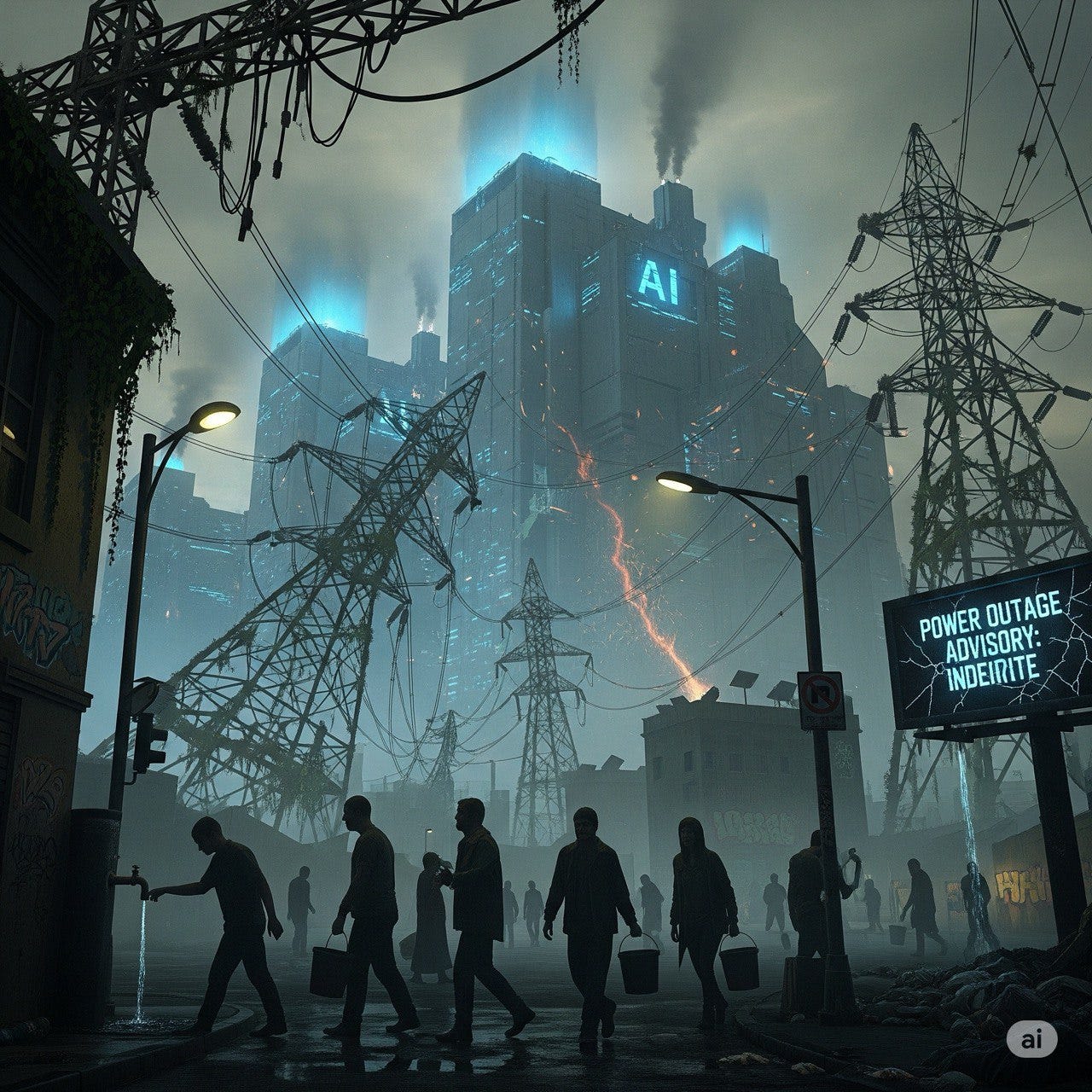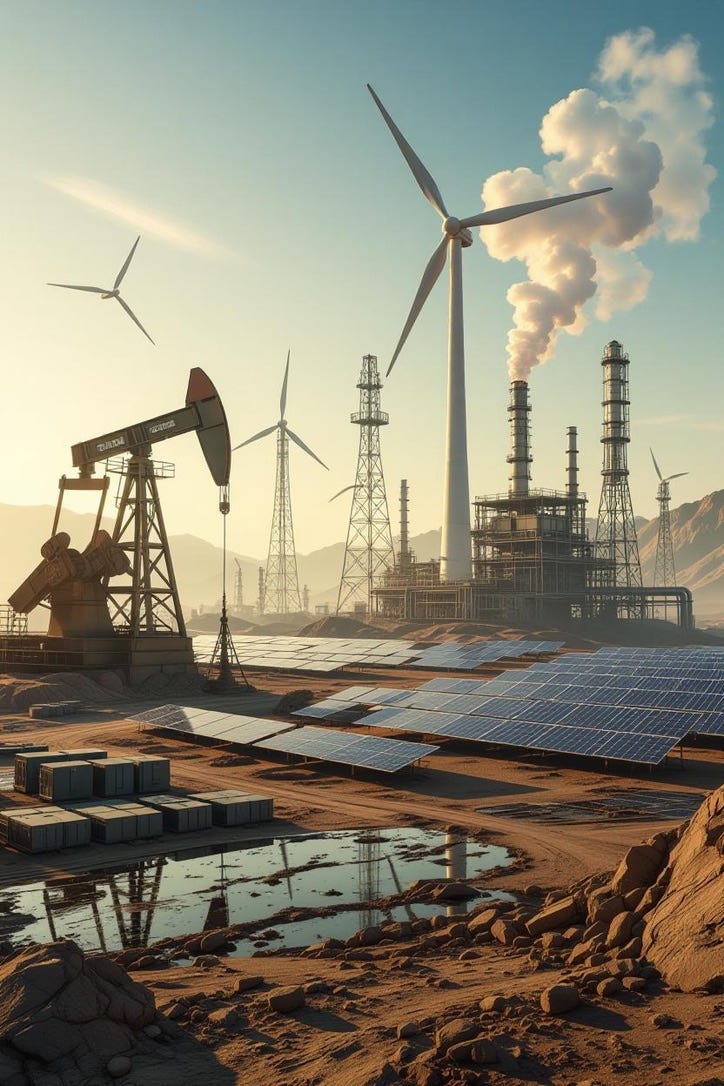Energy Return and Systemic Exchange Value
What EROEI Reveals About Global Power Transitions
This continues the series of essays reflecting on the thermodynamic substrate of our economic and social systems. The foundational theoretical paper can be found here. This essay reflects on a recent publication in Nature Communications that examines the net energy performance of nine decarbonisation global energy transition scenarios until 2050 by applying a newly developed systemwide energy return on investment (EROI) model. It’s a particularly useful paper as it provides much up to date details on EROEI - or energy return on energy invested - of different energy generation, distribution and storage systems. I ‘leverage’ the paper to think about the geopolitical and civilisation implications of energetic systems.
As the world accelerates toward net-zero energy systems, one of the most crucial, yet often misunderstood, questions is whether renewable-dominated systems can sustain the energetic foundations of industrial civilisation. At the heart of this debate lies a concept more fundamental than prices or emissions - Energy Return on Energy Invested (EROEI). A recent study published in Nature Communications by Sahin et al. offers a rigorous systemwide EROEI analysis across nine global transition scenarios, providing key insights not just for engineers and policymakers but for anyone concerned with geopolitical stability and social reproduction in the age of energy transformation.
To fully grasp what’s at stake, we must place EROEI into a broader systems context that considers how energy not only powers machines but acts as the substrate that underwrites the flows of value in an economic and social system. The Systemic Exchange Value (SEV) framework offers such a lens, positioning energy as both a physical input and an abstract enabler of exchange relations. From this standpoint, EROEI is not just an engineering metric but is also a signal of a system’s ability to generate surplus - the energy beyond what is required for self-maintenance - and thus its capacity to sustain complex interdependencies.
Three High’s: EROEI, Surplus and Complexity
Historically, high-EROEI energy systems have enabled the accumulation of complex institutions, infrastructure and geopolitical power. The golden age of fossil fuels, especially mid-20th century oil with EROEI ratios above 50:1, allowed for unprecedented surplus production. This surplus didn’t merely allow for growth but actually enabled expansive bureaucracies, vast military projection, global supply chains and discretionary consumption on a scale never before seen.
But that era is ending. The Sahin et al. study confirms that fossil fuel EROEI is in structural decline, particularly for oil and gas. Unconventional extraction methods like fracking yield net energy returns between 4:1 and 10:1, a far cry from the energy cornucopia of the past. This matters because a fall in net energy is not linear in its effects but is geometric. As EROEI approaches the “net energy cliff” (roughly 10:1), the proportion of energy available for surplus use diminishes rapidly.
In SEV terms, this erosion of surplus energy contracts the space for systemic exchange value to circulate. Institutions and markets built atop fossil fuel surpluses become harder to sustain. Sovereign power, understood and measured in energy-backed productive capacity, becomes more contested and more conditional. The complex superstructures erected upon the foundations of historic but depleting energy surpluses are now vulnerable and in some cases unsustainable.
Renewables and the Storage Dilemma
Critics of renewables often argue that wind and solar have lower EROEI than fossil fuels once storage and curtailment are factored in. The Nature Communications paper addresses this directly. It shows that while the EROEI of renewable systems does decline slightly as variable renewable energy (VRE) penetration increases, due to the energy costs of storage technologies like batteries and hydrogen systems, it remains well above the net energy cliff in all modelled scenarios.
What’s more, this decline stabilises after 100% renewable penetration is achieved. In other words, the transition incurs a temporary cost in energy investment, but the post-transition system is energetically viable and self-sustaining. Importantly, these EROEI values are amortised over the lifetimes of infrastructure, which is an essential detail often missed in headline debates.
From an SEV standpoint, this dynamic illustrates a shift not in value creation itself, but in value form. Fossil fuel systems are predicated on ongoing extraction; that is, they comprise what we can describe as a form of linear value. Renewable systems require high upfront investment but deliver circular returns over long periods. The value logic moves from throughput to durability and from flow to stock. This has implications for everything from finance to geopolitics.
Fossil Fuels and Temporal EROEI Decay
Perhaps the most important takeaway from the study is that EROEI is temporally dynamic. Fossil fuel systems are in decline. This is so not only in terms of emissions or climate ethics, but in sheer energy efficiency. In other words, the declining thermodynamic value of fossil fuel systems is not dependent on either climate change presuppositions or related, political persuasion. The study’s sensitivity analysis shows that even modest declines in the embodied energy of oil and gas can significantly degrade the EROEI of systems that remain dependent on them. This is particularly pronounced in scenarios like the IEA’s STEPS pathway, which delays full decarbonisation.
The authors explicitly note that “The EROI of fossil fuels shows a precipitous drop by 2050 due to the depletion of reserves”. They go on to say that: “IEA scenarios are extremely sensitive to the smallest changes in EROIs of natural gas and oil.” This is especially true for scenarios that delay renewable deployment. In the sensitivity analysis, when more realistic (declining) EROIs for fossil fuels are used (particularly gas and oil), the IEA’s fossil-dominant scenarios perform much worse, sometimes with a 6-point drop in system EROI. So while the paper models higher near-term EROEI for fossil-heavy systems (in some scenarios), it does not present this as sustainable or desirable. In fact, it argues that this situation creates a temporary illusion for the EROI results, and that it is inevitable that the vulnerability will be intensified in the future, and consequently, cause more dramatic falls in EROIs.
There is a strong temporal decay factor for fossil fuels. Because fossil fuels are non-renewable, stock-based resources, their exploitation follows a resource depletion curve. The easiest, most energy-rich deposits (the “low-hanging fruit”) are exploited first. Over time new discoveries are smaller, deeper, or in harsher environments (e.g. offshore, Arctic, tight shale). Extraction gets more energy-intensive (e.g. fracking, tar sands, deepwater drilling), and infrastructure must work harder for less return (declining well productivity). As a result, the energy cost of getting energy out rises and EROEI declines over time.
In contrast, renewable systems are trending upward in their technological EROEI. Solar panel efficiency is rising; energy payback times are shrinking; and battery chemistries are improving. This divergence has profound implications. Importantly, Sahin et al point out that solar and wind EROEI has been increasing, not decreasing. This is due to:
Falling energy input per unit of output (thanks to tech efficiency, learning rates);
Improved materials and processes; and
Longer lifetimes and better performance.
Some studies now estimate solar PV system EROEI above 20:1, wind possibly 30:1–70:1 in good locations, which is better than current U.S. fossil fuels. The LUT-EROI model in the paper uses life-cycle analysis and amortised energy investment, giving us a clearer picture. Even with storage, 100% renewable systems globally maintain EROEI above 10, even as they take on more enabling tech burden.
Under SEV, temporal dynamics are critical. Value must be both produced and reproduced. Systems that offer high initial returns but deteriorate rapidly are unstable forms of systemic value. They may prop up geopolitical advantage temporarily - as with the U.S. shale boom - but ultimately they hollow out the foundations of reproducible exchange value.
Geopolitical Differentiation
What does this mean geopolitically?
In the United States, the illusion of energy independence built on fracked hydrocarbons is now colliding with the reality of low-EROEI, high-decline rate resources. The United States is entering a period of mounting energetic stress, and while it’s not a collapse scenario, it does signal deep structural vulnerabilities that policymakers, markets and communities will need to reckon with. Shale oil and gas dominate U.S. fossil fuel production, but these are low-EROEI and short-lived, relatively speaking. Most of the shale sweet spots are already drilled; new wells deliver less output per unit of energy and capital invested. EROEI of shale oil is ~4–6:1, compared to the ~30:1 that powered 20th-century U.S. industrial expansion. The implication for the U.S. is that it is spending more energy to get energy, shrinking its “net energy surplus” - the energetic margin that powers everything else, whether it’s transport, manufacturing, infrastructure, social services, the military etc.
As load growth from data centres in particular, and perhaps in time EVs and wider electrification accelerates, the grid faces rising demand while upstream energy quality falls. The U.S. is approaching a point where its energy surplus is narrowing, even as its economic and military commitments remain global. AI data centres, EVs, and heat pumps are creating massive new electricity demand. But the grid is aging; many transformers, substations, and lines are decades old, and are struggling under the new demands. Reports suggest that Texas may need to shut down data centres as the distribution network crumbles under the escalating load. Legacy systems face local capacity constraints, especially in high-growth tech corridors (e.g. Northern Virginia, Silicon Valley and Texas), needing upgrading to handle bi-directional flows and variability from renewables. The U.S. needs to scale and modernise its electrical infrastructure fast; and that takes a lot of materials (copper, steel etc.), skilled labour and energy investment upfront. Meanwhile, the U.S. network is a bottleneck.
Even as shale declines, oil majors are reluctant to invest heavily in new upstream projects due to high risk, low return coupled with a shift to shareholder returns and capital discipline. Meanwhile, renewables capex is rising due to materials bottlenecks (tariffs won’t help), permitting delays and supply chain instability. The capital efficiency in U.S. energy investment is dropping. This creates bottlenecks in expanding both fossil and renewable capacity.
The U.S. faces an energetic “trilemma”. Energy quality is declining as fossil EROEI declines, and renewables require upfront investment. The rate of energy demand growth is exceeding easy-to-deploy additional supply, creating an energy quantity problem. And, transmission systems are outdated, under pressure and demanding significant upgrades. An infrastructure deficit is the third leg of the trilemma. The U.S. needs massive grid and storage upgrades, efficiency gains in all sectors - not just technology - smart integration of distributed renewables and deep investment in materials, supply chains and labour capacity. While not obvious to the naked eye, America’s era of surplus energy abundance is coming to an end.
In Europe, especially post-Ukraine invasion, the loss of high-EROEI pipeline gas from Russia has exposed energetic vulnerabilities. Replacing it with LNG from the U.S. introduces higher embodied energy costs and lower net energy returns. European deindustrialisation is not merely a response to prices, but a symptom of structural net energy decline. The SEV lens reveals this not as a market failure but as a value contraction at the energetic base. Russian gas was Europe’s high-EROEI energy backbone, especially for Germany, Italy and Eastern Europe. It continues to be, though pipelines to Hungary and Slovakia have recently been attacked by Ukraine. Replacing Russian gas with LNG is substantially more expensive and is lower in EROEI terms, requiring more processing, compression, shipping and regasification. Consequently, Europe's post-industrial economy now runs on lower net energy.
Germany has been decommissioning or offshoring energy-intensive industries (e.g. chemicals and metals). The UK and much of Western Europe are importing more finished goods while shedding industrial capacity. This is often spun as “green transition”, but it's also energy triage. The bottom line is that Europe is adapting to self-created relative energy scarcity by reducing domestic energy demand, especially industrial demand.
Meanwhile, in China, where energy planning is coordinated at a strategic level, the transition to renewables is not merely framed as a climate imperative but as a pro-sovereignty move. High-EROEI solar, wind and storage systems are being scaled not only for domestic supply, but for export as enabling technologies; they are shipped in effect as a form of geopolitical surplus. In SEV terms, China is constructing an energy infrastructure that enhances its capacity to generate exchange value for others while securing its own systemic autonomy. This makes it friends with even more countries wondering how they can mitigate risks of being bullied by declining western powers on the one hand, and boosting their own prospects of development on the other.
Rethinking Surplus and Sovereignty
We are entering a phase where surplus is no longer easy or automatic. The declining EROEI of fossil systems compresses the energy available for discretionary and redistributive functions. This has implications for everything from welfare states to military budgets. Renewable systems can deliver sustainable EROEI, but require a restructuring of how surplus is generated, stored and allocated. China dominates renewable tech supply chains (solar panels, batteries and EV motors) and downstream capabilities in green hydrogen are now expanding rapidly. Russia and the Middle East still dominate low-cost oil and gas exports. The U.S. is caught between declining domestic high-EROEI production, a need to transition faster to higher EROEI options and political constraints on reshoring or diversifying energy supply chains.
SEV helps us understand this not merely as a technical matter, but as a transformation in the very logic of value. Fossil systems produce fast surplus but deplete their basis. Renewable systems produce slow surplus, but with perpetual potential, if well managed. The challenge is not whether renewables “work,” but whether political and economic institutions are capable of managing this temporal shift.
The findings from Sahin et al. decisively rebut the claim that 100% renewable systems are unworkable from a net energy standpoint. But more importantly, they invite us to rethink the purpose of energy systems altogether. Under the SEV framework, energy is not just a technical input or a traded commodity. As I have been at pains to argue, it is the substrate of value circulation itself.
As EROEI trends diverge between fossil and renewable regimes, the stakes are not just economic or environmental. They are civilisational. Which systems will be able to sustain complex exchange relations, social cohesion and sovereignty in the decades ahead? The answer, increasingly, depends not only on who has the most energy today, but who has the most energy return from the system they choose to build.




